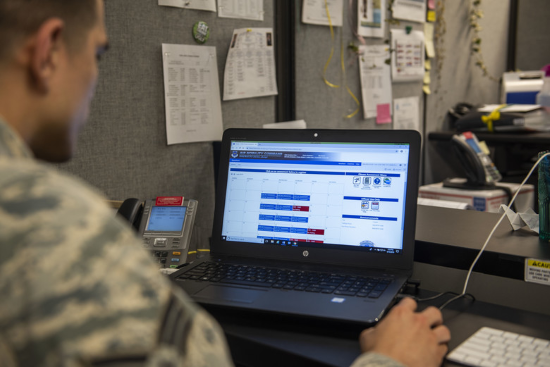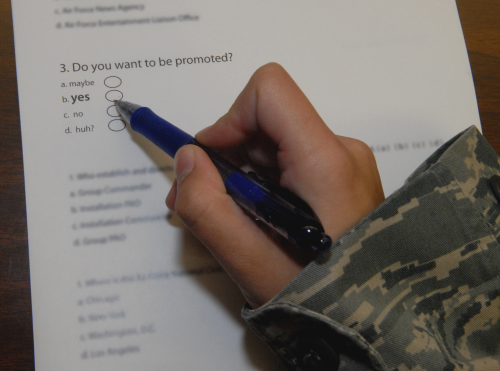PiCAT stands for the Pending Internet Computerized Adaptive Test.
This test serves as a prescreening for the ASVAB test normally used to test applicants before enlistment.
If you’re considering joining one of the branches of the U.S. military, you’ve learned that you need to take the ASVAB test.
The Armed Services Vocational Aptitude Battery (ASVAB) identifies a recruit’s potential for success in military occupations.
The AVSAB is a rigidly timed test, generally administered at MEPS and MET centers and proctored by testing monitors.
Recently, however, the Department of Defense began making use of the PiCAT test in addition to the ASVAB.
Special Note: If you need help studying for the PiCAT Test, you need to check this out.
It’s an incredibly helpful practice test and a useful strategy to help you get the best score possible.
Jump To A Section On The PiCAT Test Guide
1. What is the PiCAT Test?

The PiCAT is a computerized version of the full ASVAB. However, you can take it on any computer with internet access.
Unlike the ASVAB, potential enlistees can take the PiCAT from home with plenty of time to complete it.
Like the ASVAB, though, the PiCAT measures aptitude in the same 10 necessary skill areas. These include:
- General Science
- Arithmetic Reasoning
- Word Knowledge
- Paragraph Comprehension
- Numerical Operations
- Coding Speed
- Auto and Shop Information
- Mathematics Knowledge
- Mechanical Comprehension
- Electronics Information
Related Article – Navy Electronics Technician (AT): Career Details
The purpose of the PiCAT is to save time.
It helps recruiters identify those who may not be suitable for military service before either invest more time in the enlistment process.
2. How to Take the PiCAT Test
To take the PiCAT, you’ll need to contact your local recruiter for access to the online exam.
Your recruiter will provide an access code that will permit you to take the test. Once complete, your recruiter will contact you with your scores.
Your access code will be unique to you.
The test itself isn’t timed, but you’ll have to start the test within the time given by your recruiter, usually 72 hours.
You’ll also need to finish it within 24 hours after starting the exam.
If you decide to enlist, you’ll need to have your PiCAT score validated before you can swear in.
You have up to 30 days to validate your PiCAT scores for official purposes.
If you fail to have your scores validated in time, you may need to retake the test.
In some cases, you’ll have to take the ASVAB at a Military Entrance Processing Station (MEPS) or MET (Military Entrance Testing) center instead.
Note that only those who have not yet taken the ASVAB test can take the PiCAT. If you have already taken the ASVAB, you won’t be able to take the PiCAT.
If you wish to improve your official scores, you’ll have to retake the ASVAB, instead.
If you decide not to enlist at that time, however, your PiCAT scores remain valid for up to five years.
Related Article: 41 Questions To Ask A Military Recruiter
3. PiCAT Verification Test
In order to verify the scores of your at-home PiCAT, you’ll need to take a verification test. This verification is normally done by your recruiter, so the test is supervised. It normally takes about 20 to 30 minutes to complete.
This test is timed and proctored and takes about 25 to 30 minutes.
Once verified, your PiCAT scores will serve as your final and official ASVAB scores, which will affect the military career fields open to you in the future.
4. PiCAT Scores Breakdown
As well as testing your general education knowledge, the PiCAT also measures your aptitude for specific military occupations.
Your AFQT, or Armed Forces Qualification Test, will assess your general education and determine if you qualify for military service.
This score is derived from your PiCAT scores, using your results in Paragraph Comprehension, Word Knowledge, Mathematics Knowledge, and Arithmetic Reasoning to calculate your final score.
Each branch of the U.S. military has its own minimum standard for the AFQT, which can also vary depending on whether you’re a high school graduate or have a GED.
Related Article: Which Branch Of The Military Should I Join? 7 Things To Consider
Currently, the minimum AFQT scores for those with a high school diploma are the same for most branches of the armed forces:
- Air Force: 31
- Army: 31
- Marine Corps: 31
- Navy: 31
- Coast Guard: 36
Career Aptitude
Your aptitude for certain career fields is measured by combining your scores in the areas tested to identify whether you’re likely to find success in that field.
For each specialty, you’ll need to meet minimum score guidelines for a specific test or combination of tests.
Each branch has standards for its listed career fields, and you’ll have to meet minimum scores to qualify for those jobs.
For example, the Army assesses your aptitude for clerical work by awarding a Clerical (CL) score.
Your aptitude for clerical jobs is derived from your scores in Word Knowledge, Paragraph Comprehension, Arithmetic Reasoning, and Mathematics Knowledge.
Each branch categorizes its career fields differently and assigns a minimum score computational formula to see whether recruits qualify for that career field.
Once your PiCAT scores are validated, they will serve as your official ASVAB scores, from which you can calculate careers for which you might qualify.
- ASVAB Score Requirements for the Air Force
- ASVAB Score Requirements for the Army
- ASVAB Score Requirements for the Navy
- ASVAB Score Requirements for the Coast Guard
- ASVAB Score Requirements for the Marine Corps
Related Article – 20 Health Conditions That May Disqualify You From Military
5. How Should I Prepare for the PiCAT Test?

Special Note: As we noted earlier, if you need help studying for the PiCAT Test, you need to check this out.
It’s an incredibly helpful practice test/strategy to help you get the best score possible.
Taking the PiCAT requires the same preparation as does the ASVAB.
You can find a number of both free and paid practice tests for both tests online.
If you have recently graduated from high school or taken your SATs/CATs, you’ll find the general education tests for the PiCAT quite similar.
There may be additional skill areas you feel you may need to brush up on before taking the test, such as mechanical and electronics information, if you’re aiming for a specific career field.
Since the test assesses your natural aptitude, the official position of your recruiter may be that you should not prepare at all, except to be well-rested before testing.
However, if it has been some time since you were in an academic environment, you may want to take some refresher classes to bolster your weakest subjects.
System Requirements
Because the PiCAT is internet-based, you’ll also want to make sure your computer meets the technical requirements of the online exam.
Talk to your recruiter regarding current system requirements, as well as procedures in place if you lose your connection or have other technical difficulties.
Free PiCAT and Skills Practice Tests
You’ll find a number of resources online for assessing your skills before taking the test.
Some of these sites may also offer practice questions and refresher tutorials.
Frequently Asked Questions (FAQ)
Here are some of the questions potential recruits frequently ask about the PiCAT test:
6. How long does the test take?
You won’t be timed when you take the PiCAT, so the length of the exam depends on you.
However, the system will only give you 24 hours to complete the exam once you start it.
The home-based PiCAT has similar questions as the ASVAB, with approximately 10-16 questions in each of the 10 categories.
7. What’s considered a good score on the PICAT test?
A good score on the PiCAT will depend on which branch of the service and career field you plan to enter.
While all branches accept an AFQT score between 31 and 46, you’ll want to aim for at least 50.
This is also the minimum score to enter the service with a GED.
As far as aptitude scores, you’ll need to determine which jobs you want to qualify for to determine what scores you need.
8. What happens if I fail the PICAT test?
The PiCAT is not a pass-or-fail test.
Although you may fail to achieve the minimum score to enter your preferred branch of service.
That said, if you’re unhappy with your final score, you may be able to retake the test by coordinating with your recruiter.
9. How many times can I take the PICAT test?
Currently, there is no set policy for the number of times you can retake the PiCAT.
The DoD is still testing this relatively new program.
So, if you wish to retest the PiCAT, they may require you to take the full ASVAB instead.
Conclusion
The PiCAT is a self-administered aptitude test that the U.S. military uses to expedite the enlistment process.
In most cases, it replaces the proctored and timed ASVAB test.
Those taking the PiCAT test will need to take a timed and supervised verification test to verify the at-home PiCAT.
This verification test is much shorter, contains similar questions to the PiCAT, and takes about half an hour.
If you pass the validation test, your PiCAT scores serve as your final official ASVAB scores and remain valid for up to five years.
There are numerous practice tests available online for both the PiCAT and the ASVAB test.
However, being well-rested and having a secure internet connection are critical to success.
In order to take the PiCAT test, your recruiter can provide an official access code.
They will also provide your results and schedule you for your verification test.
The PiCAT provides your AFQT score, which every branch of the services uses to qualify you for enlistment.
Your score will determine which branches are open to you.
The PiCAT will also provide career aptitude scores, which will determine which career fields you’ll qualify for once you enlist.
References
GoArmy: Understanding the ASVAB
- Replacing Dog Tags: 6 Things You Need to Know - June 28, 2024
- Navy OAR Test Study Guide - June 24, 2024
- 10 Best Sniper Movies of all Time - June 20, 2024
Originally posted on April 27, 2020 @ 2:56 pm
Affiliate Disclosure: This post may contain affiliate links. If you click and purchase, I may receive a small commission at no extra cost to you. I only recommend products I have personally vetted. Learn more.

